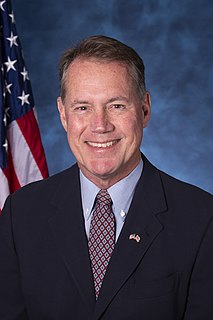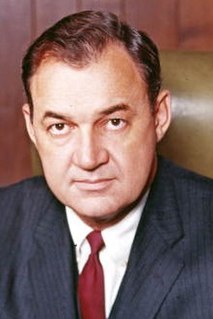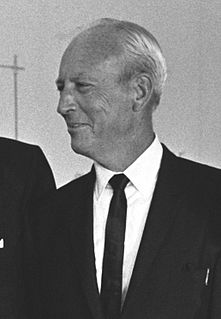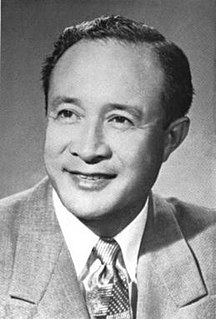
Edward Espenett Case is an American Democratic politician who is currently the U.S. Representative for Hawaii's 1st congressional district, which covers the urban core of Honolulu. He previously represented the 2nd district, which covers the rest of the state, from 2002 to 2007.

The 1982 United States Senate elections were held on November 2, 1982. They were elections for the United States Senate following Republican gains in 1980. A total of four seats changed hands between parties, and the lone independent, Senator Harry Byrd Jr., retired. Democrats made a net gain of one seat in the elections. A special election in 1983 was then held after the winner of Washington's 1982 election died at the beginning of the term.

The 1976 United States Senate elections was an election for the United States Senate that coincided with Democratic Jimmy Carter's presidential election and the United States Bicentennial celebration. Although almost half of the seats decided in this election changed parties, Carter's narrow victory did not provide coattails for the Democrats, and the balance of the chamber remained the same.

The 2010 South Carolina gubernatorial election took place on November 2, 2010. Incumbent Republican Governor Mark Sanford was term limited and unable to seek re-election. Primary elections took place on June 8, 2010 and a runoff election, as was necessary on the Republican side, was held two weeks later on June 22.

The Florida gubernatorial election of 1966 took place on November 8, 1966. During the primary election, the results from the Democratic Party was close among three of the four candidates. Thus, the top two Democrat candidates – incumbent Governor of Florida William "Haydon" Burns and Mayor of Miami Robert King High – competed in a runoff election on May 24, 1966. In an upset outcome, Robert King High was chosen over W. Haydon Burns as the Democratic Gubernatorial nominee. In contrast, the Republican primary was rather uneventful, with businessman Claude Roy Kirk Jr. easily securing the Republican nomination against Richard Muldrew. In the general election, Claude Kirk won by a margin of 55.13%-44.86% against Robert King High, becoming the first Republican Governor of Florida since the Reconstruction Era.

The 2010 Illinois gubernatorial election took place on November 2, 2010. Incumbent Democratic Governor Pat Quinn sought and was elected to a full term in office. Quinn was elected as the Democratic nominee, the Illinois Green Party nominee was attorney and 2006 nominee Rich Whitney, the Republican nominee was State Senator Bill Brady, the Libertarian Party nominee was Lex Green, and Scott Lee Cohen ran as an independent. Governor Quinn won election to a full term in a very close race, beating Senator Brady by only about 32,000 votes, despite Brady winning in 98 of 102 Illinois counties.

The Hawaii gubernatorial election of 2010 was held on November 2, 2010 to elect the next Governor and Lieutenant Governor of Hawaii. The winning candidates served a four-year term from 2010 to 2014. Incumbent Republican Governor Linda Lingle was term-limited in 2010 and not eligible to run for re-election. Former congressman Neil Abercrombie was declared the winner, defeating lieutenant governor Duke Aiona. Abercrombie was sworn in as the state's seventh Governor on December 6, 2010.

The 2014 Hawaii gubernatorial election took place on November 4, 2014, to elect the Governor of Hawaii, concurrently with a special election to Hawaii's Class III Senate Seat, as well as other elections to the United States Senate in other states and elections to the United States House of Representatives and various state and local elections.

The Missouri gubernatorial election of 1980 was Missouri's 45th gubernatorial election. The election was held on November 4, 1980 and resulted in a victory for the Republican nominee, former Governor Kit Bond, over the Democratic candidate, incumbent Governor Joseph P. Teasdale, and Socialist Workers candidate Helen Savio.

The 1959 Hawaii gubernatorial election was Hawaii's first gubernatorial election. The election was held on July 28, 1959; one month after Hawaiians had voted for statehood in accordance with the Hawaii Admission Act and one month before admission as the 50th state on August 21, 1959.

The 1966 Hawaii gubernatorial election was Hawaii's third gubernatorial election. The election was held on November 8, 1966, and resulted in a victory for the Democratic candidate, incumbent Governor of Hawaii John A. Burns over Republican candidate, State Senator Randolph Crossley. Despite the close race, Burns received more votes than Crossley in every county in the state except Honolulu, which Crossley won by less than one percentage point.

The 1970 Hawaii gubernatorial election was Hawaii's fourth gubernatorial election. The election was held on November 3, 1970, and resulted in a victory for the Democratic candidate, incumbent Governor of Hawaii John A. Burns over Republican candidate, Judge Samuel Pailthorpe King. Burns received more votes than King in every county in the state.

The 1974 Hawaii gubernatorial election was Hawaii's fifth gubernatorial election. The election was held on November 5, 1974, and resulted in a victory for the Democratic candidate, Lt. Gov. George Ariyoshi over Republican candidate, former State Senator Randolph Crossley. Ariyoshi received more votes than Crossley in every county in the state.

The 1978 Hawaii gubernatorial election was Hawaii's sixth gubernatorial election. The election was held on November 7, 1978, and resulted in a victory for the Democratic candidate, Governor George Ariyoshi over Republican candidate, State Senator John R. Leopold and three other candidates. Ariyoshi received more votes than any other candidate in every county in the state.

The 1982 Hawaii gubernatorial election was Hawaii's seventh gubernatorial election. The election was held on November 2, 1982, and resulted in a victory for the Democratic candidate, Governor George Ariyoshi over Frank Fasi, running as an Independent Democrat, and the Republican candidate, State Senator D. G. Anderson. Ariyoshi received more votes than any other candidate in every county in the state.

The 1986 Hawaii gubernatorial election was Hawaii's eighth gubernatorial election. The election was held on November 4, 1986, and resulted in a victory for the Democratic candidate, Lt. Gov. John D. Waihee III over the Republican candidate, State Senator D. G. Anderson. Waihee received more votes than Anderson in every county in the state.

The 1990 Hawaii gubernatorial election was Hawaii's ninth gubernatorial election. The election was held on November 6, 1990, and resulted in a victory for the Democratic candidate, incumbent Governor John D. Waihee III over the Republican candidate, State Representative Fred Hemmings. Waihee received more votes than Hemmings in every county in the state.

The 2018 Hawaii gubernatorial election took place on November 6, 2018, to elect the Governor of Hawaii and Lieutenant Governor of Hawaii.
Lew Wallace was an American Democratic politician from the state of Oregon. He served in both houses of the Oregon Legislative Assembly and was a five-time gubernatorial candidate.
























